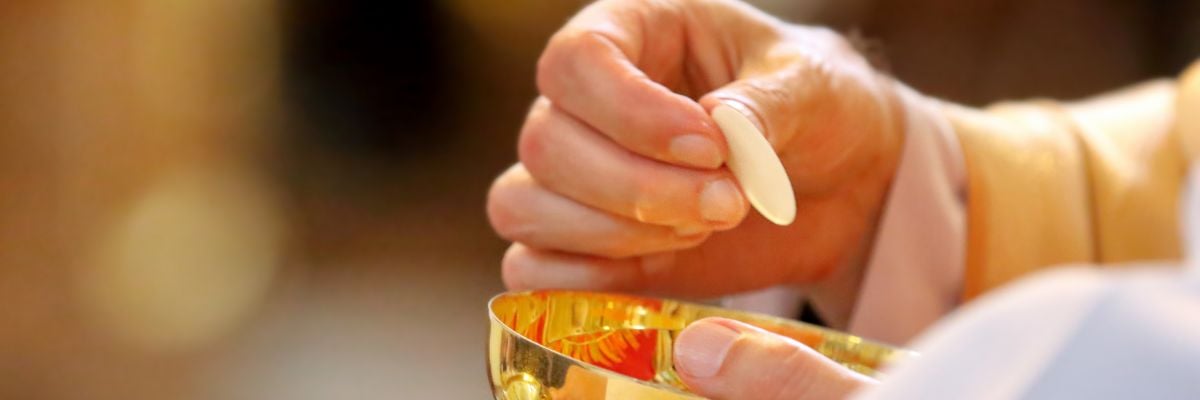
People are still talking about recent revelations that a troublingly small portion of Catholic believe in the reality of the Holy Eucharist. And talk they should, as long as this leads to prayerful action. Decades of poor catechesis and liturgical innovation could hardly have any other effect than ignorance and loss of faith. As belated efforts to reverse this trend get underway, however, catechists and clergy would do well to inform themselves of the history of this confusion so they may better defend Our Lord and form the faithful.
The Catholic Church has consistently taught the real presence of Christ in the Eucharist from its very beginning. The idea that Communion is a mere symbol of Christ’s death or a simple memorial meal is a sixteenth century theological innovation that was initially rejected even by the original Protestant reformers.
The Catholic Church, in solidarity with the vast majority of the historical Church, teaches dogmatically that after the consecration, the Eucharistic elements actually become the body, blood, soul, and divinity of Jesus Christ through transubstantiation. Why does the Church teach such a seemingly incredible doctrine? The answer is God’s revelation, recorded “by word of mouth or by letter” (2 Thess. 2:15).
The primary Scripture passages that support the Church’s teaching come from both the Gospels and the epistles. One of the clearest examples is when Jesus tells his disciples that he is
the living bread which came down from heaven; if any one eats of this bread, he will live for ever; and the bread which I shall give for the life of the world is my flesh. . . . unless you eat the flesh of the Son of man and drink his blood, you have no life in you (John 6:51,53).
Jesus’ disciples were understandably shocked and confused by these words. However, when they asked Jesus to explain, he did not do so figuratively, as he so often did with parables. Because of this, all his followers left him except the twelve apostles (John 6:66).
Exactly how people were to fulfill Jesus’ command was demonstrated at the Last Supper, where Jesus
took bread, and when he had given thanks he broke it and gave it to them, saying, “This is my body which is given for you. Do this in remembrance of me.” And likewise the cup after supper, saying, “This cup which is poured out for you is the new covenant in my blood” (Luke 22:19-20).
St. Paul affirms this reality in 1 Corinthians. First, he equates the bread and wine with the body and blood of Christ (10:16-21). Second, he states that abusing the meal is abusing Christ (11:23-28), and pronounces judgment on those who do not discern what the Eucharist really is: “For any one who eats and drinks without discerning the body eats and drinks judgment upon himself” (11:29).
Jesus’ first listeners understood his words literally, as did his apostles and those chosen to lead his Church.
So clear was the Church’s understanding of the Eucharist as Jesus’ body and blood that Christians were accused of being cannibals for defending its consumption! By the end of the first century, the Church celebrated every Sunday as a mini-Easter. St. Ignatius Of Antioch—the third bishop of Antioch—had this to say regarding the Eucharist before A.D. 110:
Consider how contrary to the mind of God are the heterodox in regard to the grace of God which has come to us. . . . They abstain from the Eucharist and from prayer, because they do not admit that the Eucharist is the flesh of our Savior Jesus Christ, the flesh which suffered for our sins and which the Father, in His graciousness, raised from the dead” (Letter to the Smyrnaeans, 6).
In the second and third centuries, eucharistic doctrine was upheld in the writings of saints like Justin Martyr (e.g., “We do not receive these things as common bread or common drink; but as Jesus Christ our Savior” – First Apology, 66) and Irenaeus (e.g., “The Word of God becomes the Eucharist, which is the body and blood of Christ” – Against Heresies, 5.2). This body of teachings only grew as the Church expanded in later centuries.
Pages could be filled with quotes from every Christian writer on the subject pointing to the same conclusion: the Church believed that Jesus Christ was the substance of the eucharistic meal. Objections to the real presence of Christ in the Eucharist did not arise until well over a millennia later.
An early third century theologian named Tertullian has often been accused of denying the Eucharist. In his response to Marcion (who denied the incarnation), Tertullian says, “Then, having taken the bread and given it to His disciples, He made it His own body, by saying, ‘This is my body,’ that is, the figure of my body” (Against Marcion, 4:40). First, it is important to note that Tertullian is not a Church Father, was never ordained, never canonized, and died a Montanist heretic. Second, saying the Lord’s body and blood are communicated under the “appearances,” “signs,” or “symbols” of bread and wine is not false. Saying it is only a “figure” is a problem – but that’s not what Tertullian said. In fact, in the very next sentence, Tertullian reminds Marcion that Jesus
declared plainly enough what He meant by the bread, when He called the bread His own body. He likewise, when mentioning the cup and making the new testament to be sealed ‘in His blood,’ affirms the reality of His body.
The first Christian writer to truly deny the truth of the Eucharist appears to have been Berengarius of Tours in the eleventh century. Berengarius held that Christ was present in the Eucharist “as mere sign and symbol” and that, “bread must remain.” Fortunately, he recanted of his heresy in 1079. It is of interest, however, that St. Thomas Aquinas calls Berengarius “the first deviser of this heresy,” (ST IIIa, q.75, a.1) which indicates that no one of import denied the Eucharist for the first 1,000 years of Christian history.
The next challenger came along 500 years after Berengarius. Although one might expect that Martin Luther was behind it, it was actually the lesser-known reformer Ulrich Zwingli, who Luther himself challenged over the real presence. A famous story recounts Luther carving “This is my body” into the table between himself and Zwingli to make his point! Zwingli became the theological forerunner of the Anabaptist movement – the first large-scale movement to deny the reality of the sacraments. So bizarre was this position that the Anabaptists were violently persecuted as heretics. . . by Protestants!
Jesus taught that communion was to be celebrated with his very body and blood. This occurs miraculously in the celebration of the Eucharist. The Church affirmed the real presence of Christ in the Eucharist from the very beginning and had no serious challenges to that teaching for 1,500 years, until a group identified as heretics by both Catholics and Protestants began to rise in popularity. Although many popular Evangelical movements within Christianity today deny the truth of the sacraments (except for baptism), the historical aberration of denying the reality of the Eucharist cannot be justified by Scripture or Tradition.



